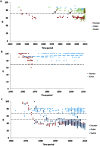Antigenically intact hemagglutinin in circulating avian and swine influenza viruses and potential for H3N2 pandemic
- PMID: 23661027
- PMCID: PMC3650665
- DOI: 10.1038/srep01822
Antigenically intact hemagglutinin in circulating avian and swine influenza viruses and potential for H3N2 pandemic
Abstract
The 2009 swine-origin H1N1 influenza, though antigenically novel to the population at the time, was antigenically similar to the 1918 H1N1 pandemic influenza, and consequently was considered to be "archived" in the swine species before reemerging in humans. Given that the H3N2 is another subtype that currently circulates in the human population and is high on WHO pandemic preparedness list, we assessed the likelihood of reemergence of H3N2 from a non-human host. Using HA sequence features relevant to immune recognition, receptor binding and transmission we have identified several recent H3 strains in avian and swine that present hallmarks of a reemerging virus. IgG polyclonal raised in rabbit with recent seasonal vaccine H3 fail to recognize these swine H3 strains suggesting that existing vaccines may not be effective in protecting against these strains. Vaccine strategies can mitigate risks associated with a potential H3N2 pandemic in humans.
Figures




Similar articles
-
Genetic and antigenic relatedness of H3 subtype influenza A viruses isolated from avian and mammalian species.Vaccine. 2008 Feb 13;26(7):966-77. doi: 10.1016/j.vaccine.2007.11.094. Epub 2007 Dec 26. Vaccine. 2008. PMID: 18206275
-
Novel Reassortant Human-Like H3N2 and H3N1 Influenza A Viruses Detected in Pigs Are Virulent and Antigenically Distinct from Swine Viruses Endemic to the United States.J Virol. 2015 Nov;89(22):11213-22. doi: 10.1128/JVI.01675-15. Epub 2015 Aug 26. J Virol. 2015. PMID: 26311895 Free PMC article.
-
Substitutions near the hemagglutinin receptor-binding site determine the antigenic evolution of influenza A H3N2 viruses in U.S. swine.J Virol. 2014 May;88(9):4752-63. doi: 10.1128/JVI.03805-13. Epub 2014 Feb 12. J Virol. 2014. PMID: 24522915 Free PMC article.
-
[Swine influenza virus: evolution mechanism and epidemic characterization--a review].Wei Sheng Wu Xue Bao. 2009 Sep;49(9):1138-45. Wei Sheng Wu Xue Bao. 2009. PMID: 20030049 Review. Chinese.
-
Swine influenza viruses: an Asian perspective.Curr Top Microbiol Immunol. 2013;370:147-72. doi: 10.1007/82_2011_195. Curr Top Microbiol Immunol. 2013. PMID: 22266639 Review.
Cited by
-
Comparative evolution of influenza A virus H1 and H3 head and stalk domains across host species.mBio. 2024 Jan 16;15(1):e0264923. doi: 10.1128/mbio.02649-23. Epub 2023 Dec 11. mBio. 2024. PMID: 38078770 Free PMC article.
-
Rapid Detection of Avian Influenza Virus by Fluorescent Diagnostic Assay using an Epitope-Derived Peptide.Theranostics. 2017 Apr 10;7(7):1835-1846. doi: 10.7150/thno.18857. eCollection 2017. Theranostics. 2017. PMID: 28638471 Free PMC article.
-
Coordinated Evolution of Influenza A Surface Proteins.PLoS Genet. 2015 Aug 6;11(8):e1005404. doi: 10.1371/journal.pgen.1005404. eCollection 2015 Aug. PLoS Genet. 2015. PMID: 26247472 Free PMC article.
-
Pathogenesis and Transmission of Genetically Diverse Swine-Origin H3N2 Variant Influenza A Viruses from Multiple Lineages Isolated in the United States, 2011-2016.J Virol. 2018 Jul 31;92(16):e00665-18. doi: 10.1128/JVI.00665-18. Print 2018 Aug 15. J Virol. 2018. PMID: 29848587 Free PMC article.
-
A multifunctional human monoclonal neutralizing antibody that targets a unique conserved epitope on influenza HA.Nat Commun. 2018 Jul 10;9(1):2669. doi: 10.1038/s41467-018-04704-9. Nat Commun. 2018. PMID: 29991715 Free PMC article.
References
-
- Cunha B. A. Influenza: historical aspects of epidemics and pandemics. Infectious disease clinics of North America 18, 141–155 (2004). - PubMed
-
- Russell C. J. & Webster R. G. The genesis of a pandemic influenza virus. Cell 123, 368–371 (2005). - PubMed
-
- Taubenberger J. K. et al. Characterization of the 1918 influenza virus polymerase genes. Nature 437, 889–893 (2005). - PubMed
-
- Scholtissek C., Rohde W., Von Hoyningen V. & Rott R. On the origin of the human influenza virus subtypes H2N2 and H3N2. Virology 87, 13–20 (1978). - PubMed
Publication types
MeSH terms
Substances
Grants and funding
LinkOut - more resources
Full Text Sources
Other Literature Sources
Medical

